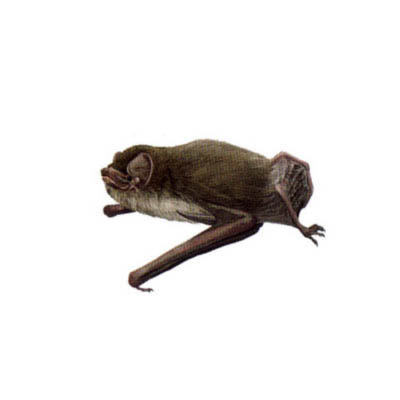Schreiber's bent-wing bat

Miniopterus schreibersii (Kuhl, 1819)
Miniopteridae
Vulnerable
| Other names | |
|---|---|
| Catalan | Ratpenat de cova de Schreibers |
| Spanish | Murciélago de cueva |
| English | Schreiber's bent-wing bat |
| French | Minioptère de Schreibers |
| Basque | Schreiber saguzar |
| Galician | Morcego das covas |
Description
Medium-sized bat, with an approximate length of 48 to 65 mm (head and body), a wingspan between 305 and 350 mm, forearm length ranging from 43 to 48 mm, a tail between 46 and 64 mm, and a weight between 9 and 16 g. The dorsal fur has a woolly appearance and is grayish, while the ventral part is lighter. The head is rounded with a sort of chin of fur. This bat has a small muzzle, small ears that are separate and triangular (12 to 13.5 mm long), not protruding above the head, and a small tragus. Like all members of the Miniopteridae family, the second phalanx of the third finger of the wing is three times as long as the first phalanx and, at rest, is bent backward.
Fotografies
Distribution
This bat has a wide distribution and is well distributed in Europe, especially in Mediterranean-influenced areas. Previously, the species was believed to extend to Australia, but recent genetic analyses have divided it into many different species, with Miniopterus schreibersii corresponding to European populations. Its distribution limits include the Iberian Peninsula, France, Italy, southern Austria, Slovakia, Romania, southeastern Europe to western Turkey, and North Africa (including Morocco, Algeria, and Tunisia).
Roosts and phenology
Throughout the year it roosts in large caves and mines. They usually occupy larger chambers during the summer, while in winter, they can be found in secondary corridors. Maternity colonies are formed since April and can become quite large, ranging from hundreds to thousands of reproducing females and their offspring. Some of the largest known colonies include 20,000 individuals in Portugal and between 30,000-60,000 individuals in Croatia and Bulgaria. In favorable environments, some of the larger caves are used year-round, while in others, its use is seasonal. Non-reproductive females and males form separate colonies. The offspring are born from mid-June to July and form large groups.
This species carries out seasonal migrations from their breeding roosts to winter roosts, using caves as waypoints along the way. On average, distances traveled are around 40-100 km, although the longest distances recorded in France and Spain are 422, 524, and 833 km. Colonies are known to cross the sea between Mallorca and Menorca during their migrations. Some winter colonies can contain up to 70,000 individuals.
Habitat and diet
Its habitat preferences are closely tied to spacious cave environments, making it particularly sensitive to cave visitation. The habitat of this species covers the entire range of Mediterranean environments, including open spaces, forests, or urban areas, but always linked to limestone areas with cave presence. The altitude limit is around 1,400 meters above sea level.
Its diet is primarily composed of relatively delicate insects, mainly moths (80%), as well as neuroptera and diptera. Its flight is fast and remarkably maneuverable, thanks to the long tail and broad uropatagium. It tends to avoid dense vegetation and can be found hunting below the tree canopy, above bodies of water, along the edges of shrub and tree vegetation, or even around urban lights at night. Highly-populated colonies make that when food availability is low, this species may have to travel considerable distances to feed, typically about 15-20 km from the roost, with maximum recorded distances of 40 km.
Echolocation
Echolocation calls exhibit a frequency-modulated/quasi-constant frequency (FM/QCF) component with a maximum intensity frequency around 49-56 kHz. The calls can be confused with those of the Soprano pipistrelle (Pipistrellus pygmaeus), which is why in ultrasound recordings, they are classified as Pipistrellus pygmaeus/Miniopterus sp..
Trends
| General trend | Moderate increase |
|---|---|
| Protocol | ChiroRoosts |
| Period | Hibernation |
| Geographic scope | Catalonia |
| Number of localities studied | 4 |
| Annual change | 3.9 % |
| Method | TRIM |
| Analysis execution date | 01/09/2024 |
| General trend | Moderate increase |
|---|---|
| Protocol | ChiroRoosts |
| Period | Migration |
| Geographic scope | Catalonia |
| Number of localities studied | 22 |
| Annual change | 3.1 % |
| Method | TRIM |
| Analysis execution date | 01/09/2024 |
| General trend | Strong decrease |
|---|---|
| Protocol | ChiroRoosts |
| Period | Reproduction |
| Geographic scope | Catalonia |
| Number of localities studied | 11 |
| Annual change | -8.7 % |
| Method | TRIM |
| Analysis execution date | 01/09/2024 |
Status
According to the IUCN Red List, this species is considered Vulnerable, with a negative population trend, and in the Red Book of Spain (2006) as VU A2ac (Vulnerable with a population reduction of 30% over the last 10 years). The species is protected in various countries by national legislation such as the Eurobats Agreement, the Bern Convention, and the Habitat and Species Directive. Its major issue is the lack of shelters due to the influx of cave tourism, and despite some conservation measures being implemented, its population continues to decline. On the other hand, it is very abundant in Turkey and the Balkans.





